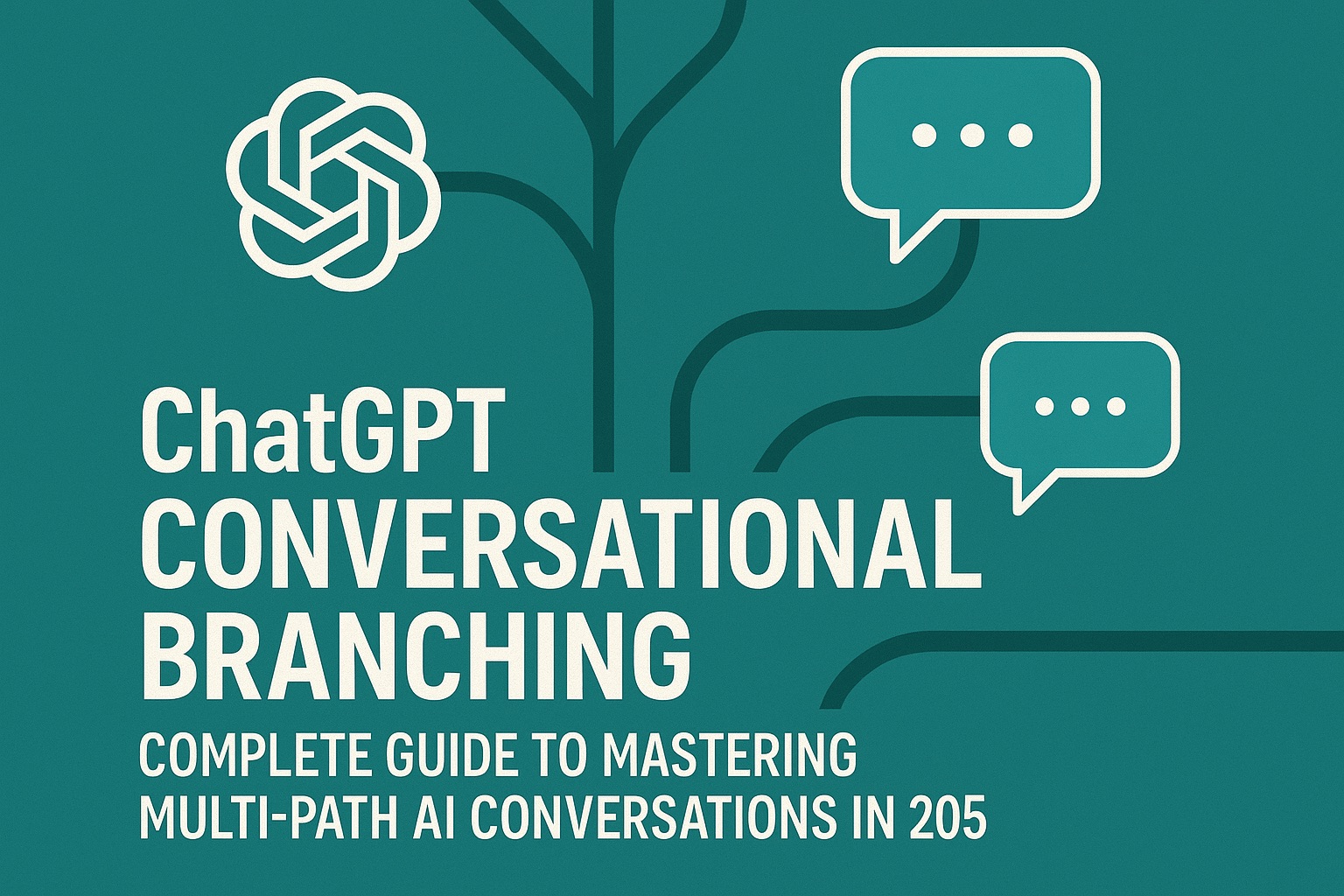Imagine you’re working on a creative writing project and want to explore three different plot directions simultaneously, or you’re developing a business strategy and need to examine multiple approaches without losing track of your original conversation thread. What if you could branch your AI conversation into separate paths, exploring each idea thoroughly while maintaining the context of your original discussion? This revolutionary capability is exactly what ChatGPT’s conversational branching feature delivers to users in 2025.
ChatGPT conversational branching represents a groundbreaking advancement in AI conversation management, allowing users to create multiple discussion threads from any point in their conversation. This innovative AI feature transforms how we interact with conversational AI by enabling non-linear exploration of ideas, concepts, and solutions without the frustration of losing valuable conversation history.
In this comprehensive guide, you’ll discover everything you need to know about ChatGPT’s conversational branching feature, including step-by-step usage instructions, real-world applications, competitor comparisons, and advanced optimization techniques that will revolutionize your AI interactions.
Key Takeaways
- Conversational branching allows you to create multiple conversation paths from any point in your ChatGPT discussion, enabling parallel exploration of different ideas
- The feature works through an intuitive interface with branch buttons that appear next to AI responses, making it accessible to users of all technical levels
- Real-world applications span creative writing, business strategy, academic research, and problem-solving, offering unprecedented flexibility in AI-assisted work
- ChatGPT’s implementation surpasses competitors by providing seamless thread management and context preservation across multiple conversation branches
- Advanced users can maximize the feature by combining it with other ChatGPT capabilities and following specific workflow optimization strategies
What is Conversational Branching?
Conversational branching is a revolutionary AI feature that allows users to create multiple discussion threads from any point in their ChatGPT conversation. Think of it as creating a conversation tree where each branch represents a different exploration path while maintaining the original context and conversation history.
Technical Implementation Behind the Scenes
The underlying technology leverages advanced context management algorithms that preserve conversation state across multiple branches. When you create a new branch, ChatGPT maintains a snapshot of the conversation history up to that point, allowing each branch to evolve independently while retaining access to the shared context that preceded the branching point.
This sophisticated system uses memory optimization techniques similar to those found in advanced text editing software that manage multiple document versions simultaneously. The AI maintains separate conversation threads in memory while ensuring seamless switching between branches without performance degradation.
Why This Feature Matters for AI Interactions
Traditional AI conversations follow a linear path, forcing users to choose one direction and potentially lose valuable alternative explorations. Conversational branching eliminates this limitation by enabling parallel idea development. This capability transforms AI conversation from a simple question-and-answer format into a dynamic, multi-dimensional exploration tool.
The feature addresses a fundamental challenge in AI interactions: the need to explore multiple ideas without losing conversation context. Whether you’re brainstorming creative concepts, analyzing business scenarios, or researching academic topics, branching conversations provide the flexibility to pursue different angles while maintaining organized discussion threads.
Step-by-Step Usage Guide: How to Use ChatGPT Conversational Branching
Mastering ChatGPT’s conversational branching feature requires understanding both the interface elements and optimal usage strategies. Follow this detailed ChatGPT tutorial to unlock the full potential of branching conversations.
Accessing the Branching Feature
- Start a conversation with ChatGPT as you normally would
- Look for the branch icon (typically a small tree or fork symbol) that appears next to AI responses
- Hover over the branch button to see the “Create Branch” tooltip
- Click the branch icon to create a new conversation thread from that specific point
Creating and Managing Branches
- Select your branching point by identifying the AI response where you want to explore alternative directions
- Click the branch button – a new tab or panel will appear showing your branched conversation
- Name your branch (optional but recommended) using descriptive titles like “Creative Approach” or “Technical Solution”
- Continue the conversation in your new branch with different prompts or questions
- Switch between branches using the tab navigation or branch selector menu
Interface Elements and Navigation
The branching interface includes several key components:
- Branch tabs at the top of the conversation window
- Branch tree visualization showing the relationship between different threads
- Context indicators highlighting shared conversation history
- Merge options for combining insights from multiple branches
Troubleshooting Common Issues
Branch not appearing? Ensure you’re using the latest version of ChatGPT and that your conversation has progressed beyond the initial exchange. The branch feature typically becomes available after the first AI response.
Performance slow with multiple branches? Limit active branches to 5-7 simultaneously for optimal performance. Consider system optimization tools to improve overall browser performance when managing complex conversations.
Lost track of branches? Use the branch overview panel to see all active threads and their relationship to the main conversation trunk.
Practical Use Cases & Real-World Examples
The versatility of ChatGPT conversational branching shines through diverse real-world applications. Understanding these practical scenarios will help you identify opportunities to leverage this powerful feature in your own work.
Creative Writing with Multiple Plot Directions
Scenario: Developing a mystery novel with three potential plot twists
- Branch 1: The butler committed the crime
- Branch 2: The victim faked their own death
- Branch 3: Multiple conspirators worked together
Each branch allows you to explore character development, plot holes, and narrative consequences without losing the foundational story elements established in the main conversation thread.
Business Strategy Exploration
Example: Launching a new product in a competitive market
- Branch A: Premium pricing strategy targeting luxury consumers
- Branch B: Competitive pricing to gain market share quickly
- Branch C: Subscription-based model for recurring revenue
This approach enables comprehensive strategy analysis while maintaining consistent market research and product specifications across all scenarios.
Academic Research with Different Angles
Application: Researching the impact of social media on mental health
- Research Branch 1: Focus on teenage demographics
- Research Branch 2: Examine workplace social media usage
- Research Branch 3: Analyze elderly population adoption patterns
Each branch can develop unique methodologies, literature reviews, and conclusions while sharing foundational research principles.
Problem-Solving with Various Approaches
Challenge: Optimizing website performance
- Technical Branch: Server-side optimizations and database improvements
- Design Branch: User interface and user experience enhancements
- Content Branch: SEO and content strategy modifications
This multi-faceted approach mirrors the functionality of comprehensive design tools that allow simultaneous work on different project aspects.
Code Development with Alternative Solutions
Programming Challenge: Implementing user authentication
- Security-First Branch: Multi-factor authentication with advanced encryption
- User-Friendly Branch: Simplified login with social media integration
- Performance Branch: Lightweight authentication optimized for speed
Each branch can explore different programming languages, frameworks, and implementation strategies while maintaining consistent project requirements.
Comparison with Competitors: ChatGPT vs Other AI Platforms
Understanding how ChatGPT’s conversational branching compares to other AI platforms helps appreciate its unique advantages and identify the best tool for specific use cases.
ChatGPT’s Unique Implementation Advantages
Seamless Context Preservation: Unlike competitors, ChatGPT maintains perfect context continuity across branches, ensuring that each conversation thread retains full access to shared conversation history. This technical superiority stems from advanced memory management similar to professional data recovery tools that preserve data integrity across multiple operations.
Intuitive Branch Management: The visual branch tree interface provides clear navigation between conversation threads, making it accessible to users regardless of technical expertise.
Unlimited Branch Depth: Users can create sub-branches from existing branches, enabling complex conversation hierarchies that mirror natural thought processes.
Competitor Analysis
Claude AI: Offers conversation threading but lacks visual branch management and context preservation across complex conversation trees.
Google Bard: Provides alternative response generation but doesn’t support true conversational branching with independent thread development.
Microsoft Bing Chat: Limited to conversation variations rather than full branching capabilities, restricting exploration depth.
Anthropic AI Assistants: Strong in conversation quality but missing the organizational tools necessary for managing multiple conversation paths effectively.
Performance Metrics Comparison
| Feature | ChatGPT | Claude | Bard | Bing Chat |
|---|---|---|---|---|
| Branch Creation | Instant | Not Available | Limited | Not Available |
| Context Preservation | Perfect | Partial | Basic | Basic |
| Visual Management | Advanced | None | None | None |
| Branch Depth | Unlimited | N/A | Single Level | N/A |
Limitations and Considerations
While ChatGPT conversational branching offers powerful capabilities, understanding its limitations ensures optimal usage and realistic expectations.
Usage Limits and Restrictions
Memory Constraints: Extensive branching with very long conversations may impact performance. The system efficiently manages memory, but users should be mindful of creating excessive branches with lengthy discussions.
Subscription Tiers: Advanced branching features may be limited to premium subscription levels, with basic users having access to fewer simultaneous branches.
Performance Considerations
Loading Times: Complex conversation trees with multiple active branches may experience slightly longer loading times, especially when switching between distant branches.
Mobile Limitations: The full branching interface works best on desktop devices, with mobile implementations offering simplified branch management.
Best Practices for Optimal Results
- Limit active branches to 5-7 for best performance
- Use descriptive branch names to maintain organization
- Regularly consolidate insights from multiple branches
- Close unused branches to maintain system efficiency
When NOT to Use Branching Conversations
Simple Q&A Sessions: Linear conversations work better for straightforward information requests.
Real-time Collaborations: Branching can complicate shared conversations with multiple participants.
Resource-Intensive Tasks: Complex computational requests may perform better in single-thread conversations.
Tips for Maximizing the Conversational Branching Feature
Advanced users can significantly enhance their experience by implementing strategic approaches and optimization techniques that leverage the full potential of ChatGPT’s branching capabilities.
Advanced Techniques for Power Users
Branch Naming Strategies: Develop consistent naming conventions using prefixes like “TECH-“, “CREATIVE-“, or “RESEARCH-” followed by descriptive titles. This systematic approach mirrors professional file management practices that maintain organization across complex projects.
Context Anchoring: Before creating branches, establish strong context anchors in the main conversation thread. Include key parameters, constraints, and objectives that will inform all subsequent branches.
Progressive Branching: Start with broad category branches, then create sub-branches for specific explorations. This hierarchical approach prevents overwhelming conversation trees while maintaining logical organization.
Integration with Other ChatGPT Features
Custom Instructions Integration: Set up custom instructions that work across all branches, ensuring consistent AI behavior while allowing branch-specific variations.
Plugin Compatibility: Many ChatGPT plugins work seamlessly across branches, enabling specialized functionality like code execution or data analysis in multiple conversation threads simultaneously.
Export and Documentation: Use conversation export features to document insights from multiple branches, creating comprehensive reports that synthesize findings across different exploration paths.
Workflow Optimization Suggestions
Branch Planning: Before starting complex projects, sketch out potential branch structures. This preparation prevents chaotic conversation trees and ensures systematic exploration.
Regular Consolidation: Schedule periodic review sessions to consolidate insights from multiple branches, preventing information scatter and maintaining project coherence.
Template Development: Create conversation templates for common branching scenarios, similar to how multimedia software uses templates for efficient project setup.
Common Mistakes to Avoid
Creating too many branches simultaneously – This leads to confusion and reduced productivity
Neglecting branch organization – Poor naming and structure make navigation difficult
Forgetting to consolidate insights – Valuable discoveries get lost across multiple threads
Overcomplicating simple conversations – Not every discussion benefits from branching
Instead, focus on strategic branching that genuinely enhances exploration and maintains clear organization throughout the process.
Future Implications and Evolution of Conversational Branching
The introduction of conversational branching represents just the beginning of a fundamental shift in AI interaction design. Understanding these future implications helps users prepare for upcoming developments and maximize long-term benefits.
Evolutionary Trajectory
Enhanced Visualization: Future updates will likely include more sophisticated branch visualization tools, potentially incorporating mind-mapping interfaces and interactive conversation flow diagrams similar to those found in advanced 3D rendering software.
Collaborative Branching: Upcoming features may enable multiple users to work on different branches simultaneously, creating shared conversation trees for team projects and collaborative problem-solving.
AI-Suggested Branching: Advanced algorithms will likely identify optimal branching points automatically, suggesting when conversations would benefit from parallel exploration paths.
Impact on AI Conversation Design
Non-Linear Thinking Support: Branching conversations better mirror human thought processes, supporting the natural tendency to explore multiple ideas simultaneously rather than forcing linear progression.
Enhanced Learning Outcomes: Educational applications will benefit significantly as students can explore different learning paths while maintaining connection to core concepts and foundational knowledge.
Potential New Use Cases
Therapeutic Applications: Mental health professionals may use branching conversations to explore different therapeutic approaches or help clients examine various perspectives on challenging situations.
Legal Research: Attorneys could explore multiple legal strategies simultaneously while maintaining consistent case facts and client objectives across all branches.
Scientific Hypothesis Testing: Researchers might use branching to explore different experimental approaches or theoretical frameworks while maintaining consistent research parameters.
The technology underlying conversational branching will likely influence other software applications, potentially inspiring similar features in professional productivity tools and creative software platforms.
Conclusion: Mastering the Future of AI Conversations
ChatGPT conversational branching represents a revolutionary advancement in AI interaction technology, transforming how users explore ideas, solve problems, and engage with artificial intelligence. This comprehensive feature enables unprecedented flexibility in conversation management while maintaining the context and continuity essential for productive AI interactions.
The practical applications span virtually every field where structured thinking and systematic exploration provide value. From creative professionals developing multiple narrative directions to business strategists examining various market approaches, conversational branching offers the organizational framework necessary for complex, multi-faceted projects.
Key advantages that set ChatGPT apart from competitors include superior context preservation, intuitive visual management, and unlimited branching depth. These technical capabilities, combined with seamless integration with existing ChatGPT features, create a powerful platform for advanced AI-assisted work.
Success with conversational branching requires understanding both its capabilities and limitations. Strategic branch planning, consistent organization practices, and regular consolidation of insights across multiple threads ensure maximum productivity and prevent the confusion that can arise from poorly managed conversation trees.
Actionable Next Steps
- Start experimenting with simple branching scenarios to build familiarity with the interface and workflow
- Develop personal organization systems for branch naming and management that align with your specific use cases
- Integrate branching into existing projects where multiple approaches or perspectives would provide value
- Share insights with colleagues and collaborators to expand the practical applications within your organization
- Stay updated on feature developments and new capabilities as ChatGPT continues evolving this groundbreaking technology
The future of AI conversation lies in flexible, multi-dimensional interactions that support natural human thinking patterns. By mastering conversational branching now, users position themselves at the forefront of this technological evolution, ready to leverage increasingly sophisticated AI collaboration tools as they emerge.
Whether you’re tackling complex creative projects, developing business strategies, conducting research, or solving technical challenges, ChatGPT conversational branching provides the organizational framework and exploration flexibility necessary for success in our increasingly complex digital landscape. The investment in learning this feature will pay dividends as AI becomes an even more integral part of professional and creative workflows.
For those seeking to optimize their overall digital workflow alongside AI conversations, consider exploring system optimization tools that ensure your computing environment can handle the demands of advanced AI features effectively.




Post a comment